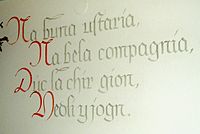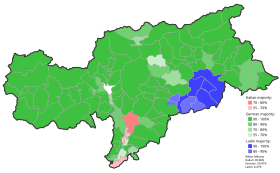
Back Ladinies Afrikaans Ladinische Sprache ALS Idioma ladino AN اللغة اللادينية Arabic Idioma ladín AST Ladinisch BAR Ladėnu kalba BAT-SMG Ладински език (реторомански) Bulgarian Ladineg Breton Ladí Catalan
| Ladin | |
|---|---|
| lingaz ladin, ladin | |
 | |
| Native to | Italy |
| Region | Ladinia (Trentino-Alto Adige/Südtirol Veneto) |
| Ethnicity | Ladin people |
Native speakers | 41,129 (2006[1]–2011[2][3]) |
Indo-European
| |
Standard forms | |
| Dialects | |
| Latin script | |
| Official status | |
| Regulated by | The office for Ladin language planning Ladin Cultural Centre Majon di Fascegn Istitut Ladin Micurà de Rü Istituto Ladin de la Dolomites |
| Language codes | |
| ISO 639-3 | lld |
| Glottolog | ladi1250 |
| ELP | Ladin |
| Linguasphere | 51-AAA-l |
| Languages of South Tyrol. Majorities per municipality in 2011: | |
|---|---|
 |
| Languages of Trentino. Percentage per municipality in 2011: | |
|---|---|
 |
| Languages of the Province of Belluno. Recognized Ladin area | |
|---|---|
 |
Ladin (/ləˈdiːn/ lə-DEEN,[5][6] UK also /læˈdiːn/ la-DEEN;[7] autonym: ladin; Italian: ladino; German: Ladinisch) is a Romance language of the Rhaeto-Romance subgroup, mainly spoken in the Dolomite Mountains in Northern Italy in the provinces of South Tyrol, Trentino, and Belluno, by the Ladin people.[8] It exhibits similarities to Romansh, spoken in Switzerland, as well as Friulian, spoken in north-east Italy.
The precise extension of the Ladin language area is a subject of scholarly debate. A narrower perspective includes only the dialects of the valleys around the Sella group, while wider definitions comprise the dialects of adjacent valleys in the Province of Belluno and even dialects spoken in the northwestern Trentino.[9][10]
A standard variety of Ladin (Ladin Dolomitan) has been developed by the Office for Ladin Language Planning as a common communication tool across the whole Ladin-speaking region.[11]
- ^ Cite error: The named reference
veneto2006was invoked but never defined (see the help page). - ^ Cite error: The named reference
altoadige2011was invoked but never defined (see the help page). - ^ Cite error: The named reference
trentino2011was invoked but never defined (see the help page). - ^ Hammarström, Harald; Forkel, Robert; Haspelmath, Martin; Bank, Sebastian (24 May 2022). "Ladin". Glottolog. Max Planck Institute for Evolutionary Anthropology. Archived from the original on 7 October 2022. Retrieved 7 October 2022.
- ^ "Ladin". Merriam-Webster.com Dictionary. Merriam-Webster. Retrieved 15 February 2015.
- ^ "Ladin". Lexico UK English Dictionary. Oxford University Press. Archived from the original on 22 March 2020.
- ^ "Ladin". Collins English Dictionary. HarperCollins. Retrieved 15 February 2015.
- ^ Sakalis, Alex (22 November 2021). "Italy's Most Mysterious Region Has Warrior Princesses and a Marmot Obsession". The Daily Beast. Retrieved 10 October 2023.
- ^ Giovan Battista Pellegrini: Ladinisch: Interne Sprachgeschichte II. Lexik. In: Lexikon der Romanistischen Linguistik, III. Tübingen, Niemeyer 1989, ISBN 3-484-50250-9, p. 667: È necessaria innanzi tutto una precisazione geografica circa l'estensione del gruppo linguistico denominato «ladino centrale», dato che le interpretazioni possono essere varie.
- ^ Johannes Kramer: Ladinisch: Grammatikographie und Lexikographie. In: Lexikon der Romanistischen Linguistik, III. Tübingen, Niemeyer 1989, ISBN 3-484-50250-9, p. 757: Im folgenden sollen die Grammatiken und Wörterbücher im Zentrum stehen, die das Dolomitenladinische im engeren Sinne ([...] Gadertalisch [...], Grödnerisch, Buchensteinisch, Fassanisch [...]) behandeln, während Arbeiten zum Cadorinischen [...] und zum Nonsbergischen [...] summarisch behandelt werden.
- ^ "The office for Ladin language planning". Archived from the original on 8 August 2007. Retrieved 10 August 2005.